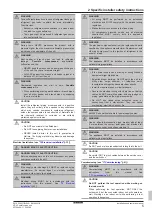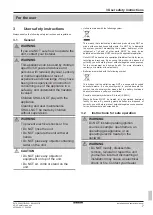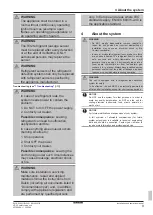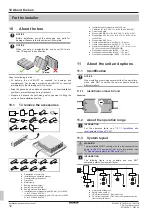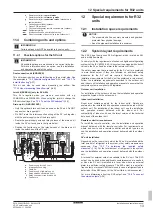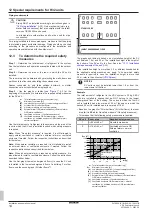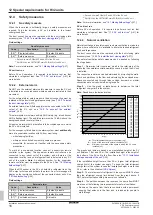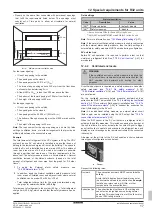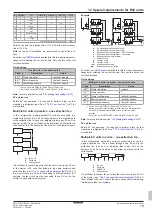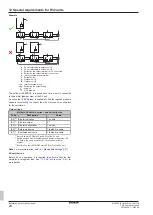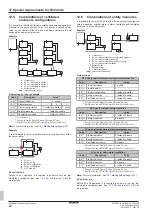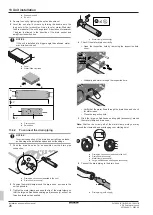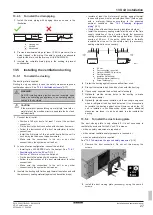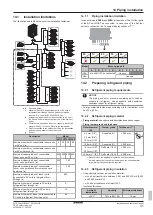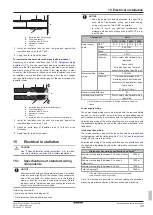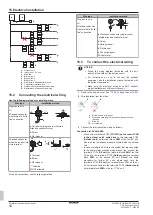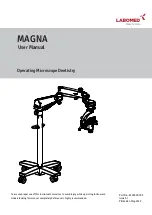
12 Special requirements for R32 units
Installation and operation manual
19
SV1ASV4~8A14AJV1B
VRV 5 safety valve unit
4P709466-1 – 2023.09
Nº
Indication
Type
AFR [m³/h]
Length [m]
∆P [Pa/m]
∆P [Pa]
6
b
Duct
“
2
1
2
7
d
Expander
“
-
-
4
8
e
Duct
“
6
0.5
3
9
f
Reducer
“
-
-
6
10
b
Duct
“
2
1
2
11
b
Duct
“
1
1
1
12
g
Non-return valve
“
-
-
11
13
b
Duct
“
1
1
1
14
h
Wall grill
“
-
-
15
Total pressure drop (sum of rows 1 to 14)
114.3
Select a fan with the required flow of 115 m³/h and a total pressure
rise of 114.3 Pa.
Note:
For ease of installation, we recommend to use in-line duct
fans.
An online tool (
) is available to find the required pressure
capacity for selecting the correct fan size. Only use this online tool
for the calculation.
Field settings
One SV unit – one extraction fan
Code
Description
Value
[2-0]
(a)
Cluster indication
0 (default): disable
[2-4]
(b)
Safety measures
1 (default): enable
[2-7]
(b)
Ventilated enclosure
1 (default): enable
(a)
Set on ALL main PCBs (A1P and A2P) of the SV unit.
(b)
Set ONLY on the LEFTMOST main PCB (A1P) of the SV unit.
Note:
37].
SV unit test run
Before SV unit operation, it is required to perform a test run that
simulates a refrigerant leak. See
41] for
more details.
Multiple SV units in parallel – one extraction fan
In this configuration, multiple parallel SV units are connected to a
single extraction fan. Each SV unit benefits from a direct airflow path
to the extraction fan. In case of a refrigerant leak in any SV unit, the
damper of that SV unit will open and allow direct air evacuation to
the extraction fan. The dampers of the other SV units remain closed.
a
1
a
2
a
...
b
c
a
#
SV unit #
b
Ductwork
c
Extraction fan
It is sufficient to connect the extraction fan circuit to only one SV unit
of the cluster (=SV units that belong to the same ductwork and
extraction fan) (see
"15.6 To connect the external outputs"
36]). If
in a cluster there are SV units that belong to different outdoor unit
systems, the fan circuit must be connected to one SV unit (in the
cluster) of each outdoor unit system.
Example
a
a
a
A
c
e
c
e
d
e
e
f
b
a
a
A
c
e
d
e
d
e
e
B
e
f
a
SV unit belonging to outdoor unit A
b
SV unit belonging to outdoor unit B
c
Extraction fan output terminal – NOT connected
d
Extraction fan output terminal – connected
e
Interconnection wiring terminal
f
Extraction fan
A
Outdoor unit A
B
Outdoor unit B
Interconnection wiring
Extraction fan output wiring
An online tool (
) is available to find the required pressure
capacity for selecting the correct fan size. Only use this online tool
for the calculation.
Field settings
Multiple SV units in parallel – one extraction fan
Code
Description
Value
[2-0]
(a)
Cluster indication
1: enable
[2-1]
(a)
Cluster number
#
(b)
[2-2]
(a)
Cluster configuration
0 (default): parallel
[2-4]
(c)
Safety measures
1 (default): enable
[2-7]
(c)
Ventilated enclosure
1 (default): enable
(a)
Set on ALL main PCBs (A1P and A2P) of the SV unit.
(b)
Assign a unique cluster number to each cluster in the system. All
SV units in the same cluster MUST have the same cluster
number.
(c)
Set ONLY on the LEFTMOST main PCB (A1P) of the SV unit.
Note:
For more information, see
37].
SV unit test run
Before SV unit operation, it is required to perform a test run that
simulates a refrigerant leak. See
41] for
more details.
Multiple SV units in series – one extraction fan
In this configuration, multiple SV units are connected in series to a
single extraction fan. The air flows through every SV unit to the
extraction fan. In case of a refrigerant leak in any SV unit, the
dampers of all SV units will open and allow air evacuation to the
extraction fan.
a
a
a
d
b
c
c
b
b
a
SV unit
b
Ductwork
c
EKBSDCK
d
Extraction fan
It is sufficient to connect the extraction fan circuit to only one SV unit
of the cluster (see
"15.6 To connect the external outputs"
36]). It
is not allowed to have SV units in the same series cluster that belong
to different outdoor unit systems.
Summary of Contents for VRV 5
Page 47: ......

